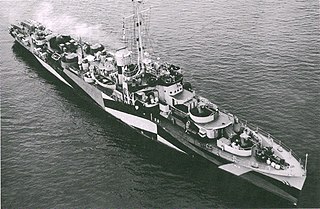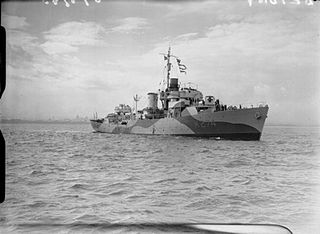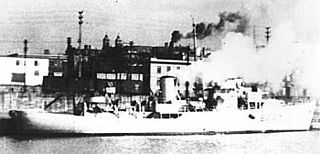
A corvette is a small warship. It is traditionally the smallest class of vessel considered to be a proper warship. The warship class above the corvette is that of the frigate, while the class below was historically that of the sloop-of-war. The modern types of ships below a corvette are coastal patrol craft, missile boat and fast attack craft. In modern terms, a corvette is typically between 500 tons and 2,000 tons, although recent designs may approach 3,000 tons, which might instead be considered a small frigate.
HMT Ballarat, built for P&O in 1911 to expand its Blue Anchor Line subsidiary. Requisitioned as a troopship in the First World War. On 25 April 1917 a German submarine torpedoed her in the English Channel. All her passengers and crew were rescued and she was taken in tow, but she sank the next day.
Several Canadian naval units have been named HMCS Vancouver. One was named for the explorer George Vancouver, the others after the city of Vancouver.

The second USS Gallup (PF-47), a Tacoma-class frigate in commission from 1944 to 1945 and from 1950 to 1951, was the first ship of the United States Navy to be named for Gallup, New Mexico. She also served in the Soviet Navy as EK-22 and in the Royal Thai Navy as HTMS Prasae.
Two ships of the Royal Navy have borne the name HMS Lotus, after the Lotus flower:
Two ships of the Royal Navy have borne the name HMS Peony, after the flower:
Eight ships of the Royal Navy have borne the name HMS Satellite:
Three ships of the Royal Navy have borne the name HMS Arabis, after the flower, the Arabis.
Three Royal Navy ships have been names HMS Snapdragon, after the flower:
Three ships of the Royal Navy have been named HMS Arbutus:
The following ships of the Royal Thai Navy have been named Bangpakong:

HMS Betony was a Flower-class corvette of the British Royal Navy. She was ordered in 1941, and commissioned in August 1945. She was immediately transferred to the Royal Indian Navy, where she was commissioned as HMIS Sind. She was transferred back to the Royal Navy in May 1946, as the war ended just days after her transfer. She was then sold to the Royal Thai Navy in 1947 as HTMS Prasae, and eventually scuttled in 1951.
HMS Polyanthus was a Flower-class corvette of the Royal Navy. She was launched on 30 November 1940 from Leith Docks on the Firth of Forth, at an estimated cost of £55,000. Polyanthus was sunk by the German submarine U-952 using new German weapons technology on 20 September 1943 about 1,000 miles southwest of Reykjavík during convoy escort duty in the Battle of the North Atlantic.
At least three ships of the Royal Navy have been named HMS Candytuft :

The Kingdom of Thailand was one of the 21 countries who responded to the United Nations request to send troops to aid South Korea during the Korean War 1950-1953. As well as being one of the first countries to openly express its support for South Korea's cause, whilst also being one of the UN's larger contributors to the war. Thai support was important to battles determining the outcome of the war, including Pork Chop Hill and the Third Battle of Seoul.

HMCS North Bay was a modified Flower-class corvette that served with the Royal Canadian Navy during the Second World War. She fought primarily in the Battle of the Atlantic as a convoy escort. She was named for North Bay, Ontario.

HMCS Whitby was a modified Flower-class corvette that served with the Royal Canadian Navy during the Second World War. She fought primarily in the Battle of the Atlantic as a convoy escort. She was named for Whitby, Ontario.

HMCS Trentonian was a modified Flower-class corvette that served with the Royal Canadian Navy during the Second World War. She fought primarily in the Battle of the Atlantic and the English Channel as a convoy escort. She was named for Trenton, Ontario, though due to a naming conflict with another vessel, her name was changed. She was sunk in 1945.
Three ships of the Royal Navy have been named HMS Godetia :
Two ships of the Royal Navy have been named HMS Verbena:
This page is based on this
Wikipedia article Text is available under the
CC BY-SA 4.0 license; additional terms may apply.
Images, videos and audio are available under their respective licenses.






